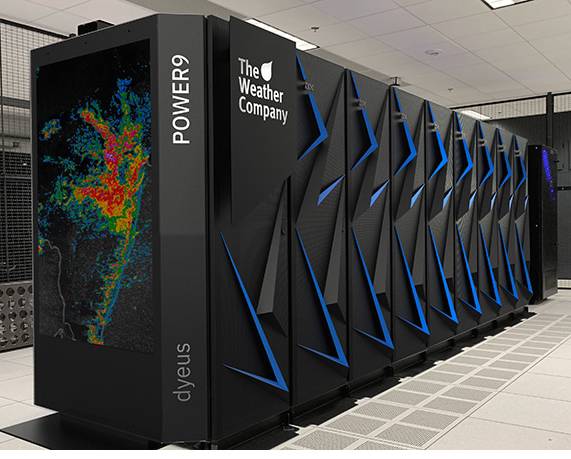 In this video, scientists describes IBM GRAF, a powerful new global weather forecasting system that will provide the most accurate local weather forecasts ever seen worldwide. Deployed at The Weather Company, the IBM Global High-Resolution Atmospheric Forecasting System (GRAF) is the first hourly-updating commercial weather system that is able to predict something as small as thunderstorms globally. Compared to existing models, it will provide a nearly 200% improvement in forecasting resolution for much of the globe (from 12 to 3 sq km).
In this video, scientists describes IBM GRAF, a powerful new global weather forecasting system that will provide the most accurate local weather forecasts ever seen worldwide. Deployed at The Weather Company, the IBM Global High-Resolution Atmospheric Forecasting System (GRAF) is the first hourly-updating commercial weather system that is able to predict something as small as thunderstorms globally. Compared to existing models, it will provide a nearly 200% improvement in forecasting resolution for much of the globe (from 12 to 3 sq km).
GRAF uses advanced IBM POWER9-based supercomputers, crowdsourced data from millions of sensors worldwide, and in-flight data to create more localized, more accurate views of weather globally. IBM says its new supercomputer, DYEUS, built just to run the model, will issue 12 trillion pieces of weather data every day and process forecasts every hour, while many global weather models update only every six to 12 hours.
Today, weather forecasts around the world are not created equal, so we are changing that,” said Cameron Clayton, general manager of Watson Media and Weather for IBM. “Weather influences what people do day-to-day and is arguably the most important external swing factor in business performance. As extreme weather becomes more common, our new weather system will ensure every person and organization around the world has access to more accurate, more finely-tuned weather forecasts.”
As we address climate change and intensifying severe weather, it’s more critical now than ever to have access to timely, reliable forecasting services around the world. Unfortunately, not all forecasts are created equal. To help address this issue, IBM’s The Weather Company has launched a powerful new forecasting tool called IBM GRAF. The hourly-updating Global High-Resolution Atmospheric Forecasting System (IBM GRAF) improves global model resolution by 3x, helping to bring the rest of the world’s forecasts up to the standard once limited to a small number of countries. Created in collaboration with NCAR and running on a GPU-accelerated IBM supercomputer, IBM GRAF is the world’s first operational high-resolution, hourly-updating model that covers the entire globe. It helps democratize weather forecasts so people, businesses and governments — anywhere — can make better weather-related decisions.
IBM GRAF’s speed, accuracy and resolution depend on massive computing power, a new weather model and the use of a wide variety of data from traditional and new sources.
A system that delivers high-resolution, global, hourly-updating forecast models needs infrastructure that can not only accommodate big data but can also supply massive computing capacity and advanced graphic rendering. This powerful new system is composed of 84 nodes of the IBM Power Systems AC922 server and 3.5 petabytes, or 3.5 quadrillion bytes, of IBM Spectrum Scale Storage. This is the same IBM POWER9 and IBM Storage technology used by the U.S Department of Energy’s supercomputers Summit and Sierra, the most powerful and smartest supercomputers in the world. Predictions from the new system will be made available globally in 2019.
All of that computing power is brought to bear on a new, advanced prediction model that resulted from a highly collaborative effort. Developed by the National Center for Atmospheric Research (NCAR) in concert with the climate modeling group at Los Alamos National Laboratory, it was later refined in collaboration with IBM and The Weather Company.
This is a great example of basic research leading to private sector applications,” said Antonio Busalacchi, president of the University Corporation for Atmospheric Research, which manages NCAR for the National Science Foundation.
IBM GRAF’s predictive capabilities, and global forecasting science as a whole, will continue to advance with improved data collection around the globe. As weather models use increasingly fine resolutions, Busalacchi said, it’s even more important to pull in data from nontraditional sources. IBM GRAF will eventually use data from airplane sensors and individual smartphones, if people choose to share them. “That’s where IBM has a role in terms of its ability to take advantage of those observations” and improve the models, Busalacchi said.
Sign up for our insideHPC Newsletter





